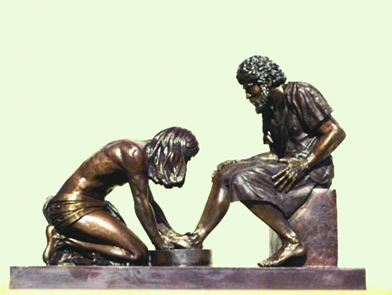|
This Act was enacted in 1823 in Britain and was designed to regulate the behaviour of both employers and employees.
The wording of the title of the Act gives some indication of which group the Act favoured.
Infringements of the act by either party were punishable by law and included fines and imprisonment. In reality it was only the Masters who had to resources to avail themselves
of the Act's provisions.
The Act helped perpetuate the class system and it was in force in Western Australia until 1900 when it was replaced by the Arbitration Act. Although some amendments were
made through out the years, the Act was always slanted in favour of the employer.
In the early years of settlement in Western Australia the Act was strictly applied. The attitude of the ruling classes is summed up by an 1881 article in the West Australian
newspaper which said in part:
"Nowadays all children are kept in elegant idleness at school until they are 13 or 14. It was better and healthier when poor children were taken into service at the age of about 7."
Conditions for many of the 'working poor' during the early years of settlement were not far removed from outright slavery. Domestic servants fared much worse than every day labourers
because they were usually friendless and subject to the whims of their employers.
Abortion and infanticide were not uncommon for women who were taken advantage of. When children were not disposed of in these matters they could be left in what became known
as 'baby farms'. One instance of this was detected in West Perth where about 12 infants were sick with dysentery and some close to death. This case led directly to the institution of the
State Children's Act of 1907.
The two groups that probably suffered most under the Master and servant Act were the imported Chinese labourers and the
Aboriginies. Neither group evoked much sympathy and in many cases severe neglect led to a number of completely avoidable deaths.
Aborigines in particular were forced to sign indentures that they did not understand. Groups were effectively kidnapped and brought before a magistrate (usually a man of the same
social standing and with very similar interests to the 'employer') and made to sign papers they could not hope to comprehend. If they absconded they were hunted down and severe
punishments were handed out.
In the late 1880s and through the 1890s, labour began to become more organised and unions started to take shape. This was the beginning of the end for the old Act but it took a series
of strikes to start to bring the change about.
Fremantle was at the centre of the labour disputes with the Lumpers' Union taking action on several occasions. A strike in 1899 lasted 5 weeks.
When the new Act became law in 1901 the criminal prosecutions were replaced by a system of arbitration.
There are those today who question the value of unions. I would suggest they take heed of the following examples of how workers were once treated:
Rules for teachers 1872
From 'Rockingham The Visions Unfold' R. Draper
1. Teachers each day will fill lamps , trim wicks and clean chimneys.
2. Each morning the teacher will bring a bucket of water and a scuttle of coal for the day's session.
3. Make your pens carefully. You may whittle nibs to the individual taste of the pupils.
4. Men teachers may take one evening each week for courting purposes or two evenings if they attend Church regularly.
5. After ten hours in school, the teachers may spend the remaining time reading the Bible or any other good books.
6. Women teachers who marry or engage in unseemly conduct will be dismissed.
7. Every teacher should lay aside from each pay a goodly sum of his earnings for his benefit during his declining years so that he will not become a burden on society.
8. Any teacher who smokes, uses liquor in any form, frequents the pool or Public Halls, or gets shaved in a Barber Shop will give good reason to suspect his worth, intention,
integrity and honesty.
9. The teacher who performs his labour faithfully and without fault for five years will be given an increase of twenty-five pence per week in his pay, providing the Board of
Education approves.
Few people realise just how much the union movement in Australia contributed to the improvement of working conditions for almost every worker.
Let's step back for a little while to the 1880s and see just how bad things were:
Labourers working in camps had little or no sanitation. Employers argued that providing sanitary collection services was a blow against free enterprise. The death of a labourer
was no loss to an employer as they cost nothing to train and were easily replaced.
Butchers and bakers usually worked between 70-90 hours a week. Barmen could often work 15-17 hours a day, six days a week plus and extra 2 hours on Sunday. Shop assistants
work 12-14 hours a day on weekdays and from 7am till midnight on Saturdays. Almost all shop workers worked at least 60 hours a week and grocers' assistants worked 12 hours a day 6 days a week.
Barmaids were ruthlessly exploited and were employed mostly by the physical attractiveness. Many worked 14-18 hours a day. A waitress could expect to work 75 hours a week.
As their beauty faded so did their employment prospects until many could find no work at all besides prostitution. It was said there were three final stages to many barmaids lives,
'going among Chinamen, then to hospital, then to the grave.'
Even after laws began to be passed to tighten up on the worst abuses of workers, there were few inspectors and some of the existing ones would even telegraph their inspections
to the employers ahead of time so that under-age workers and other workers that might prove to be inconvenient, could be removed from the premises during the inspection.
It was only organised unions with representatives in every work place and full-time government officials with the support of governments that brought an end to the tyranny imposed by
employers over their work forces.
|







